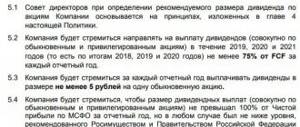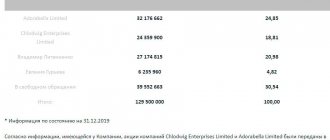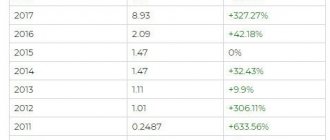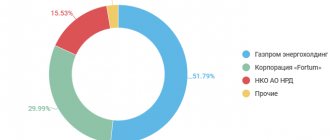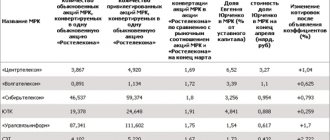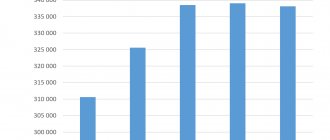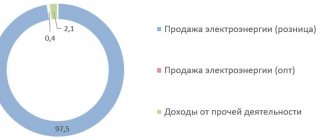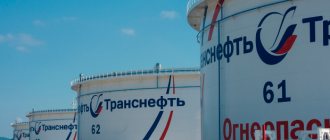Dividend policy
The current version was adopted on September 11, 2007, no changes were made. The basis for calculating NCSP dividends is net profit according to IFRS standards; a specific payout ratio is not fixed. The percentage of profits distributed to shareholders fluctuates widely.
When determining its size, the General Director provides justification for each area of the planned expenditure of funds.
Principles of dividend policy:
- respect for the rights and interests of shareholders;
- increasing capitalization, liquidity and investment attractiveness of NCSP;
- transparency of payments.
The decision to pay dividends to NCSP is made at the annual general meeting of shareholders based on the recommendations of the board of directors. The following factors are taken into account:
- net profit;
- return on equity and assets;
- solvency and financial stability;
- debt capital ratio;
- sufficiency of own working capital;
- ensuring priority areas of development within the framework of investment policy.
Conditions for payment of dividends by NCSP:
- no legal restrictions;
- maintaining the required level of financial condition of the company;
- availability of net profit.
All company dividends for the last 10 years
| For what year | Period | Last day of purchase | Registry closing date | Size per share | Dividend yield | Closing share price | Payment date |
| 2019 | 24 Jul 2020 | July 28, 2020 | 12M 2019 | 1,35 ₽ | 12,59% | 11 Aug 2020 | |
| 2018 | June 21, 2019 | June 25, 2019 | 12M 2018 | 0,5 ₽ | 6,44% | 9 Jul 2019 | |
| 2018 | 4 Jan 2019 | 9 Jan 2019 | 9M 2018 | 0,2648 ₽ | 3,82% | 23 Jan 2019 | |
| 2017 | 5 Oct 2018 | 9 Oct 2018 | 6M 2018 | 0,519216 ₽ | 7,43% | 23 Oct 2018 | |
| 2016 | May 25, 2017 | May 29, 2017 | 12M 2016 | 0,7788237 ₽ | 10,09% | June 12, 2017 | |
| 2015 | 12 Sep 2016 | 14 Sep 2016 | 6M 2016 | 0,467 ₽ | 9,63% | 28 Sep 2016 | |
| 2015 | 1 Jul 2016 | 5 Jul 2016 | 3M 2016 | 0,0519216 ₽ | 1,23% | July 19, 2016 | |
| 2014 | 9 Jul 2015 | 13 Jul 2015 | 12M 2014 | 0,2336 ₽ | 12,29% | July 27, 2015 | |
| 2013 | July 7, 2014 | 9 Jul 2014 | 12M 2013 | 0,023364 ₽ | 1,04% | July 23, 2014 | |
| 2012 | April 28, 2013 | April 28, 2013 | 12M 2012 | 0,02362 ₽ | 0,8% | May 10, 2013 | |
| 2011 | April 25, 2012 | April 25, 2012 | 12M 2011 | 0,0235 ₽ | 0,74% | May 9, 2012 | |
| 2010 | May 11, 2011 | May 11, 2011 | 12M 2010 | 0,023 ₽ | 0,69% | May 25, 2011 | |
| 2009 | April 19, 2010 | April 19, 2010 | 12M 2009 | 0,125 ₽ | 2,21% | May 3, 2010 |
Deal delayed
PJSC NCSP owns ports in Novorossiysk, Primorsk and Baltiysk and ranks third in Europe in terms of cargo turnover. The deal was completed amid criminal prosecution of the sellers - the owners of Summa, brothers Ziyavutdin and Magomed Magomedov . Transneft planned the deal back in February 2021, when the Federal Antimonopoly Service approved the sale of a stake in Summa. But the negotiations were suspended due to the arrest of the Magomedovs. They are accused of stealing 2.5 billion rubles from the federal and regional budgets and organizing a criminal community.
Immediately after the announcement of the deal, analysts rushed to note that the amount paid by Transneft was almost twice the value of the shares on the stock exchange at the time of the announcement. On the evening of October 8, NCSP’s capitalization on the Moscow Exchange amounted to 124.3 billion rubles, the Magomedovs’ share was worth 31.14 billion rubles, or about $467 million. “The price looks very strange, because the company’s capitalization, based on the share price on the market, is half the amount of the transaction. It is quite possible that the initial agreement provided for a fixed amount, and the main framework of the transaction was known already in February-March 2021,” says Finam Group analyst Alexey Korenev.
Ziyavudin Magomedova’s asset manager Leila Mammedzade, the ex-head of the Summa group, which closed the deal, called in an interview with RBC the price of NCSP shares “fair and correct”, given the significant growth potential of the asset, and the new main shareholder as the natural owner. She also confirmed that the deal was almost completed in March 2018, when the Magomedov brothers were arrested. But in the end, the deal was closed with the original terms agreed upon back in March. The conversation about the sale itself began in 2021, when the port was tasked with transferring all shareholders to Russian jurisdiction.
“In my opinion, the deal is completely market-based, given the infrastructure that Transneft is acquiring,” notes Alexey Bezborodov, director of the industry agency Infranews. “The transaction amount could have been higher, because this is the largest infrastructure facility in Russia,” says INFOLine CEO Ivan Fedyakov .
Summa and Transneft bought the Cypriot Novoport Holding from a number of large entrepreneurs in 2011. The amount of the transaction was not disclosed then, but, according to Vedomosti, it amounted to 2.5 billion US dollars, however, the net costs could have remained at the level of 350 million dollars, since the day before the joint offshore of Summa and Transneft sold Omirico Ltd NCSP Primorsky Port for $2.153 billion. In 2013, corporate conflicts began between Summa and Transneft. Both sides publicly accused each other of not maintaining parity on the board of directors and of developing ports in the interests of only one of the shareholders. In 2015, Summa and Transneft were going to divide their assets into “dry” and “liquid”, but the state shareholder represented by Rosimushchestvo got involved in a corporate conflict and the parties abandoned mutual claims.
Now Transneft is the controlling owner of NCSP. In total, the company owns 60.6% of the shares (Transneft owns 10.5% of the shares through its subsidiary Transneft-Service, 50.1% through the Cyprus offshore). Another 20% of the shares belong to the Federal Property Management Agency, the rest belongs to minority shareholders. The company has already announced that Transneft will transfer the ownership structure of NCSP under Russian jurisdiction.
Transneft does not yet plan to make a mandatory offer to minority shareholders. “Indeed, at this stage, Transneft can avoid issuing a mandatory offer, since the deal was concluded at the offshore level and is not subject to Russian corporate law. However, if Transneft transfers Novoport Holding, an offshore company that owns 51 percent of the shares of NCSP Group, back to Russia, then it may be recognized as affiliated with Transneft, which will become a trigger for the offer,” comments Aton analyst Alexander Kornilov .
Stock return
NCSP did not pay large dividends. This is due to the purchase of a port in Primorsk (Baltic Sea) in 2011. Available funds were used to pay off debt. Until 2012, more than 0.2 rubles. per share was not accrued.
The years 2015 and 2021 were the most generous in terms of profitability, although in absolute terms the payments were smaller. 90% of free cash flow was distributed among shareholders. In 2021, NCSP planned to allocate $150 million for dividends, but litigation got in the way.
| Year | Profitability, % |
| 2019 | 10,20 % |
| 2018 | 7,40 % |
| 2017 | 10,10 % |
| 2016 | 10,80 % |
| 2015 | 12,30 % |
| 2014 | 1,00 % |
| 2013 | 0,80 % |
| 2012 | 0,74 % |
| 2011 | 0,69 % |
| 2010 | 2,21 % |
In 2019, they paid one of the most generous dividends. According to experts, 2020 will be even better. NCSP's business has not been growing in recent years, but its financial position is stable due to the repayment of foreign currency debts.
From the proceeds from the sale of the Novorossiysk grain terminal 35.5 billion rubles. NCSP will allocate 10 billion rubles for dividends. It will cost at least 0.54 rubles. per share (6.8%) excluding the share of net profit, which will also be used for payments.
Since Transneft has become the main shareholder, the dividend policy may change. It is likely that the payment level will be fixed at 50% of net profit under IFRS. In the near future they will present an updated development strategy for NCSP, and everything will become clear. According to positive forecasts, in 2020 they will pay 1.09 rubles per share.
- NCSP Group
NCSP Group is the leading stevedoring operator in Russia and ranks third among European ports in terms of cargo turnover. The NCSP Group includes nine stevedoring companies of various specializations that operate in the ports of the Azov-Black Sea and Baltic basins.
NCSP Group includes the two largest ports in Russia in terms of cargo turnover - Novorossiysk on the Black Sea and Primorsk on the Baltic Sea, which provides it with a leading position in the Russian stevedoring services market.
The port of Novorossiysk is the largest port in the Azov-Black Sea Basin (ASB) and Russia.
In 2021, the cargo turnover of the port of Novorossiysk amounted to 93.8 million tons (excluding CPC volumes), including NCSP Group 85.1 million tons. NCSP Group companies account for 31.2% of the cargo turnover of all ports in the Azov-Black Sea basin (according to ASOP data).
Primorsk is the sixth largest Russian port in terms of cargo turnover (53.5 million tons in 2021) and ranks third among the ports of the Baltic Basin. NCSP, part of the Group, handles 100% of cargo in the port of Primorsk (according to ASOP). The Group’s second port in the Baltic is the container terminal of Baltic Stevedoring Company LLC in the port of Baltiysk in the Kaliningrad region, which in 2018 handled 70% of the total container turnover of the Kaliningrad region, which amounted to 194 thousand TEU (1.3 million tons).
Port of Novorossiysk
The port is located in the eastern part of the Black Sea on the shores of Novorossiysk (Tsemes) Bay.
Competitive advantages of the port of Novorossiysk:
· Favorable geographical location. The port is located at the intersection of international transport corridors connecting Russia with the Mediterranean, the Middle East, Africa, South and Southeast Asia, North and South America;
· The only deep-water port in the south of Russia. NCSP Group operates the deepest sea berths in the CIS and Baltic region: the maximum depth of oil berths is 24.5 m; berths for transshipment of bulk, general and container cargo - 14.5 m;
· Favorable natural conditions. The ice-free Tsemes Bay ensures year-round operation, and the existing fortification structures and breakwaters in the port serve as sufficient protection for facilities in the port, allowing to minimize the time of forced downtime due to weather conditions;
· Availability of a sufficient number of indoor and outdoor storage areas;
· High level of equipment with modern reloading equipment;
· Developed road, railway and pipeline infrastructure;
· Versatility of assets, allowing you to quickly respond to changes in the conditions of the Russian and global cargo transportation market.
Port Primorsk
The port is located on the mainland of the Björkesund Strait in the Gulf of Finland in the Baltic Sea.
Competitive advantages of the port of Primorsk:
· The largest port for transshipment of oil and petroleum products in the North-West region of Russia. The port is the end point of the Baltic pipeline system, through which oil is transported from the fields of the Timan-Pechersk, West Siberian and Ural-Volga regions of Russia;
· A modern and promising transport hub in the North-West of Russia. The port was built in 2001-2005, and as a result does not require large expenses for major repairs and reconstruction;
· Favorable geographical location. The port is located near the countries of Western and Northern Europe at the intersection of European foreign trade and transit cargo flows;
· Favorable natural conditions provide the possibility of year-round operation of the port and navigation with a short period of ice navigation;
· Natural depths.
· The maximum depth at the berths is 17.8 m;
· Own fleet.
Port Baltiysk
The port is located on the shore of the Baltic Strait, connecting the Kaliningrad (Vistula) Lagoon with the Baltic Sea, at the entrance to the Kaliningrad Sea Canal, which serves for the passage of ships from the Baltic Sea to the Kaliningrad seaport.
Competitive advantages of the port of Baltiysk:
· Favorable geographical location. The port is located in the center of the Baltic Sea near the countries of Western and Northern Europe;
· Natural depths. The port is located at the entrance to the Kaliningrad Sea Canal in its deep-water part, which allows it to receive large-capacity vessels with a permitted draft of 9.2 m;
· Favorable natural conditions. The ice-free water area ensures year-round operation of the port. Unlike the ports of Kaliningrad, the location at the entrance to the open sea creates favorable navigation conditions for linear shipping, since the need to navigate ships through the Kaliningrad Sea Canal is eliminated;
· Availability of a sufficient number of storage areas;
· Developed transport infrastructure. The port has a developed network of transport communications with the European part of Russia and the countries of Central and Eastern Europe, including the ability to send goods by rail with Russian and European gauge. Direct road communication with Kaliningrad significantly speeds up the delivery of goods.
How to buy shares and receive dividends
NCSP ordinary shares are traded on the Moscow and London exchanges (1 lot - 100 shares). You can purchase securities only through a licensed broker by concluding an agreement. The broker will independently withhold 13% of the personal income tax; you will not have to fill out a declaration. It is worth taking into account broker and exchange commissions, which reduce the final profitability.
Best brokers
List of licensed brokers that are trustworthy:
Reliable Russian brokers
| Name | Rating | pros | Minuses |
| Finam | 8/10 | The most reliable | Commissions |
| Opening | 7/10 | Low commissions | Imposing services |
| BKS | 7/10 | The most technologically advanced | Imposing services |
| Kit-Finance | 6.5/10 | Low commissions | Outdated software and user interface |
Warning about Forex and BO
Expert opinion
Vladimir Silchenko
Private investor, stock market expert and author of the Capitalist blog
Ask a Question
Work with real assets (NCSP shares) is carried out only on stock exchanges. Binary options and Forex trading (contracts for difference) are high-risk trading, leading to the loss of invested funds in 80% of cases. It is advisable to stay away from such ways of earning money.
